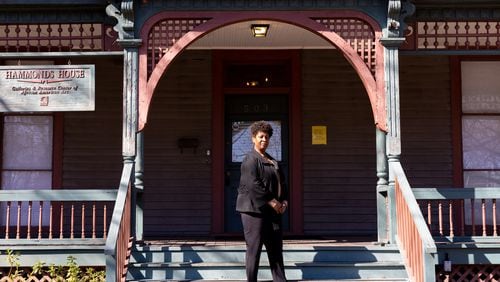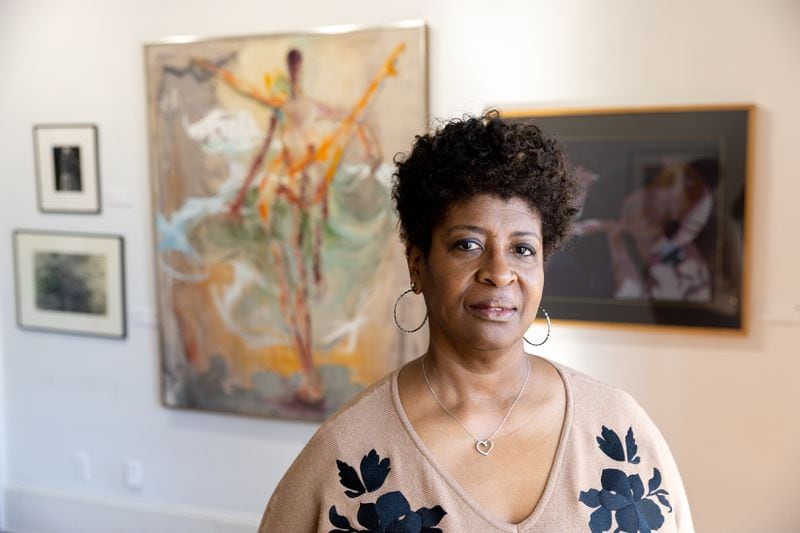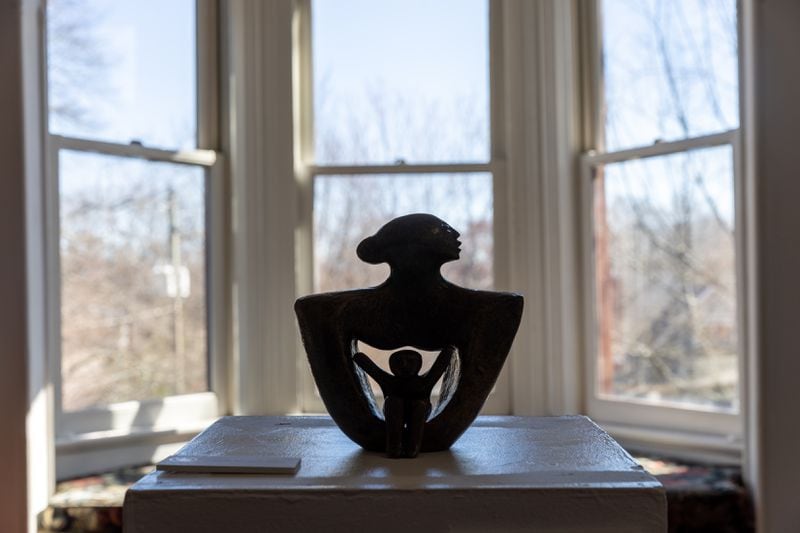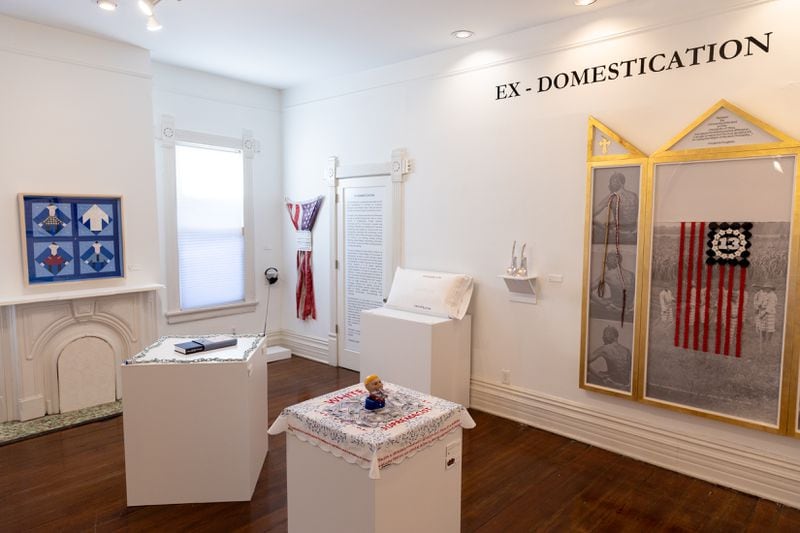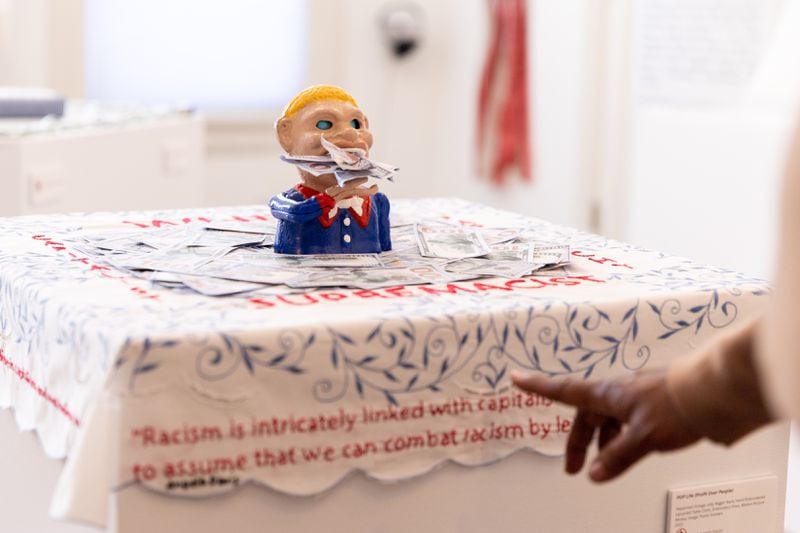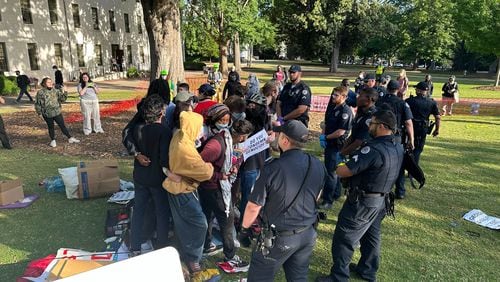Nestled on a quiet street just off I-20 west of downtown in a stately Victorian home is the Hammonds House Museum, a repository of more than 450 pieces of Black art from the past three centuries. Its front yard is bordered by a brick and wrought iron fence and large trees line the corner lot that houses the 4,000-square foot home.
But the calm setting belies the turmoil the museum in Atlanta’s historic West End faced a few years ago, from which its leaders say the institution has now emerged.
In 2020, the pandemic forced the Hammonds House to shut its doors.
But once the biggest impacts of the pandemic were fading, in early 2022, former executive director Karen Comer Lowe was fired less than a year on the job over differing views between herself and the board about the museum’s future, leading to an outcry from the local Black arts community and another temporary closure of the museum. Concerns were also raised about the condition of the collection.
But on a recent Wednesday, Donna Watts-Nunn, managing director of the Hammonds House Museum, said this year, “feels like a fresh spring start. … We outlived COVID, we outlived any negative press.”
Watts-Nunn, who had been with the museum in a variety of roles since 2015, was named managing director after Comer Lowe’s ouster and is working on increasing the capabilities of the institution.
She is currently the only full-time staff member, but hopes in the next few years to bring on a permanent artistic director, have the collection appraised and some maintenance completed.
Credit: arvin.temkar@ajc.com
Credit: arvin.temkar@ajc.com
From a home to a museum
The house at 503 Peeples St. SW was always destined to showcase art, although not necessarily as a formal museum. In the 1970s, Dr. Otis Thrash Hammonds, a prominent local Black anesthesiologist and supporter of the arts, was looking for more space, a home where his art didn’t have to be hung on doors and windows. In 1979, he purchased a dilapidated, 19th-century home in the West End and spent the next few years restoring it.
But he only got to live in his new place for a short time. Dr. Hammonds died in 1985, leaving the future of the house uncertain. Eventually, Fulton County purchased the house and his 250-piece art collection, and in 1988, the Hammonds House Museum opened to the public.
The collection has grown to more than 450 items and includes work by famed sculptor Elizabeth Catlett, the late Atlanta artist Radcliffe Bailey and the earliest known painting by Robert S. Duncanson.
Credit: arvin.temkar@ajc.com
Credit: arvin.temkar@ajc.com
The mansion has around a dozen rooms, five of which serve as exhibition spaces, according to Watts-Nunn. The other rooms are used for administrative purposes.
The future
Last year, the museum celebrated its 35th anniversary with a series of four exhibits, artist talks, artmaking workshops and community events. And last month, the museum announced curator and author Halima Taha would be joining as artistic chair for the next three years, tasked with strategic planning, education and curation for the museum.
Watts-Nunn hopes to be able to raise enough funds for a permanent artistic director.
When asked about the conservation needs of the collection, Watts-Nunn said the collection was recently assessed and there are not a lot of pieces that need work, but she hopes to be able to bring on a collections manager.
But the collection has not been appraised since at least the mid-2000s, so Watts-Nunn is working with Taha (who has extensive experience as an appraiser) to determine its value.
Credit: arvin.temkar@ajc.com
Credit: arvin.temkar@ajc.com
Taha’s inaugural exhibit, which opened in January and runs until April 14, is “The Fabric of Our Lives: The Ties That Bind & Ex-Domestication” by North Carolina-based textile artist Precious Lovell. In “The Ties that Bind,” Lovell has sewn 15 aprons, reimagining an item that is traditionally associated with women’s work by instead using them as a canvas to honor her female ancestors.
In “Ex-Domestication,” Lovell uses embroidery, sculpture and other artifacts for a searing exploration of how Black women’s labor has been exploited, the intermingling of capitalism and racism and the lasting impacts of “domestication” on society today.
Credit: arvin.temkar@ajc.com
Credit: arvin.temkar@ajc.com
Fulton County still owns the Hammonds House and the land it sits on, though a separate nonprofit entity is in charge of the museum’s operations. Fulton employees maintain the property, but job cuts at the county level have meant delayed maintenance and forced Watts-Nunn to consider hiring the work out.
In financials reported to the Internal Revenue Service in 2022, the most recent year available, Hammonds House reported about $457,000 in revenue, the bulk of it from grants and contributions, and the museum reported about $146,000 more in revenue than expenses.
For the upcoming fiscal year, the county has proposed $200,000 of the general fund be allocated to the Hammonds House. Watts-Nunn said about a third of their budget comes from Fulton County.
But Watts-Nunn said the county funding isn’t enough to bring the Hammonds House Museum to its full potential. She said the community needs to rally around the institution:
“We need you.”
The Atlanta Journal-Constitution and Report for America are partnering to add more journalists to cover topics important to our community. Please help us fund this important work at ajc.com/give
